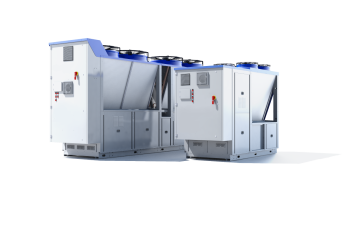8 ways to save energy with a commercial HVAC system
With energy prices fluctuating and the road to net-zero underway, we all need to consider ways to cut our energy use, for the sake of both the environment and affordable running costs. The good news is that when it comes to improving the energy efficiency of your commercial HVAC system, there is much you can do. Eurovent Certita Certification (ECC) has the following top tips…
1) Review your HVAC system and whole building efficiency with an energy audit
First and foremost you need to understand how your system functions in real life, to see where it can make gains in energy performance. An energy audit will tell you how much energy your system consumes, and when, where and how that energy is expended. An audit taking in the whole building will show where improvements can me made to the system’s use and functionality, alongside the energy efficiency rating of the property.
2) Use programmable controls, thermostats or smart controls
When it comes to thermal comfort, one of the easiest ways to stop waste is to make sure spaces are only conditioned when they are occupied. A programmable controller will let you set a time and temperature schedule for each working day. This is idea for workplaces such as offices that operate a set 9-5 and are closed over the weekend. Programmable controllers let you set the schedule, so there’s no more relying on the last person out to door to turn everything off.
Installing thermostatic controls can also help bring energy and costs down by setting temperatures that allow the system to work more efficiently. Turning the thermostat up by 1oC in cooling mode or down 1oC in heating mode can save a surprising amount of energy, while still keeping a good level of thermal comfort for occupants.
Smart controls offer the ultimate in system control. Not only can systems be controlled remotely - which can be very handy on bank holiday Monday, when you’ve forgotten to change the schedule – but they can integrate with other smart tech too. Systems can be set up with movement sensors to put your HVAC system in a lower energy ‘sleep mode’ when no movement in present, and can talk to weather sensors, allowing the system to adapt to changes in humidity and outside temperature.
Ensuring your system controls are adjusted to changes in the season is also vitally important. Bad thermal comfort = bad productivity and energy waste. No one wants business premises overheating in mild weather or freezing during the colder months. Not only will you incur unwanted heating or cooling costs, but your workforce productivity will suffer too.
3) Educate end users on energy efficiency
If the end user doesn’t understand how to run a HVAC system efficiently, or how important it is to stop energy escaping a building, then there’s always going to be a limit to the improvements you can make. Simple changes to behaviours can create energy savings. As mentioned, steps such as turning air conditioning off in unused rooms, or changing the thermostat by 1oC can help make a big difference. Stopping the escape of conditioned air by closing windows and doors when HVAC units are in operation will reduce the amount of work a system has to do. Something as simple as closing blinds on hot days can also help reduce the demand placed on your HVAC.
4) Maintain your HVAC systems regularly
It should come as no surprise that well maintained systems work more effectively, efficiently and have longer lifespans than unmaintained systems. Regularly maintained systems are also less prone to breakdowns, or issues such as harmful refrigerant leaks.
Simple jobs like checking and replacing dirty filters should be undertaken monthly and can save on your energy use. Dirty filters can restrict airflow (making systems work harder) and compromise indoor air quality.
All components of your HVAC system should be inspected, including any ductwork or pipework. If you find a problem, don’t delay fixing it. Remember, when it comes to maintenance, servicing or repairs of HVAC systems, you should always employ a professional engineer.
5) Make your building more energy efficient
Buildings that leak energy will leak money from your bank balance too. If your building lacks suitable insulation, your system will have to work much harder to achieve and retain the required indoor temperature. Areas that require conditioned air need to be well insulated, or you will lose all the benefit to the atmosphere. Put simply, your HVAC system will only be as efficient as the building it sits within.
Special attention needs to be given to the very fabric of the building and how areas are used e.g. temperature requirements and energy waste will be very different in a reception area, where external doors open the building to the elements, compared to an internal office. It’s likely therefore that different areas of the building may need different measures in place to increase the overall efficiency rating of the premises. It may also be that some spaces (e.g. loading bays) should not be conditioned, because of the levels of energy waste.
6) Switch to VRF
The pace of technological change is fast in the HVAC industry, so if you have an old and inefficient system, it really is time to switch to a new energy efficient model. When it comes to commercial buildings, Variable Refrigerant Flow (VRF) sits at the top of energy efficient building solutions. VRF systems adapt refrigerant flow depending on system demand, so it only ever uses the exact amount of energy required to heat or cool a room. Additionally, heat recovery VRF increases efficiencies further by extracting unwanted heat from one zone to deliver heating to another. Depending on the type of system you replace and your heating and cooling demands, switching to VRF could save you up to a third on your energy bills.
7) Upgrade elements of your existing HVAC system
If your system is falling behind in the efficiency steaks, but still has a lot of life left, there are a number of ways you can improve the sustainability of your existing HVAC kit. We’ve already covered adding programmable controls, thermostats and smart controls. Depending on your system, you may be able to upgrade your condenser to use microchannel heat exchangers, replace the compressor, or retrofit variable speed alternatives for fans, blowers, motors etc. Different options will be available for different systems, so ensure you engage a professional to discuss your requirements.
8) Choose certified HVAC products
Last but not least, did you know that the best way to choose an energy efficient HVAC component or system, is to compare independently verified products to make an informed decision?
Certified products:
- Are evaluated according to the same criteria, with the results expressed in the same unit of measurement, regardless of the country where the products are manufactured or marketed
- All go through exactly the same certification, auditing and surveillance process
- Plus the ‘certify-all’ principal (attached to a large number of Eurovent Certified Performance programmes), means that manufacturers cannot pick and choose flagship models for certification. Every model in the range is submitted and has to pass set criteria to be certified.
Which all means that:
- There’s no nasty surprises - the system will perform as expected, and to the required energy efficiencies
- In times of fluctuating fuel costs, you can more effectively anticipate energy bills
- Peace of mind that systems comply with regulations, standards and codes
- Certification keeps standards and innovation high. Certified products have reliability built in.
Our certified product directory is an easy to use search facility, that lets you view products by family, type, brand, model name and certificate number.
Search for energy efficient certified products now





